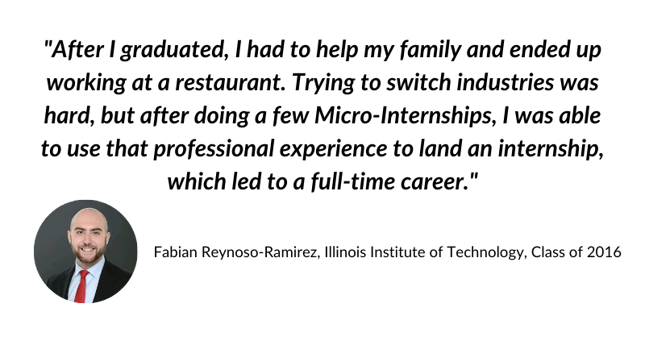.png)
Why Traditional Internships Aren't Always an Option
In this post, we explore three student groups often barred from participating in conventional internship programs—and how they can seek other professional experiences.
For students, the perks of internships are many: applying lectures and labs to real-world scenarios, meeting graduation requirements, building professional networks, creating the possibility of landing a full-time role. (The proof is in the pudding—NACE reports that completing internships increases job offers by 16%, with 70% of companies extending a full-time offer post-internship.) And while students gain relevant work experience, employers get one step closer to their bottom line—a win-win for both groups.
Today’s student, however, doesn’t fit one singular profile. While internships work for some, they’re not a feasible option for all students—especially those navigating demanding responsibilities, from family to financial to schedule obligations.
In this post, we’ll take a look at three types of students often barred from access to the traditional internship— working students, non-traditional students, and student-athletes—and how your company can offer a more accessible alternative.
Traditional internships help set students up for success—but aren't always accessible.
No two ways about it: Internships give students a leg up. Those who complete one or more are likelier to participate in class discussions, graduate with higher GPAs and secure higher-paying jobs post-graduation. Internships typically last for a 16-week semester or the duration of a summer, and require anywhere between 10 and 40 hours of student’s time per week. 33% of these opportunities are unpaid.
It follows, then, that internships are more easily accessible for those from families with higher incomes and those without part time jobs. Many students, though, are unable to sacrifice time in their schedules—especially when they could be working for compensation in other capacities.
Non-traditional students
Unlike historically “traditional” college students—those who are financially dependent and enrolled in undergraduate studies within a year of earning their high school diploma—non-traditional students may have more responsibilities to manage. (Think parents, career-changers, or those who returned to school at a later point in life.) It’s not uncommon for a non-traditional student to enroll in courses part-time to maintain their already busy schedules. And for some, adding more working hours to their schedule in the form of an internship isn’t a possibility.
It's worth noting that 47% of students enrolled in post-secondary education in the United States are over the age of 25. (Though age is just one of the characteristics of a non-traditional student.) With such a large population of non-traditional students, companies are needing to rethink their more traditional internship opportunities. (Read on to the last section for an internship alternative!)
Working students
A classmate of the non-traditional student is the working student—an individual who takes on the responsibility of part-time jobs to pay for essential costs like rent, meals, entertainment and even tuition.
While part-time work provides valuable soft skills development and exposure to difficult situations, these jobs can’t always compete with relevant professional experience as it relates to a student’s degree.
For some, part-time work is a non-negotiable part of the student’s schedule that occurs during what would traditionally be viewed as study time during nights and weekends. Finding the time to search, apply to, interview for, and attend events related to internships is less likely to fit into the schedule of a working student.
Moreover, unpaid internships could require a student to decrease the number of paid hours they are able to work. While some students compromise their finances to accept an unpaid internship, the choice to pursue experiential learning shouldn’t be a financial sacrifice.
Student-athletes
It’s no secret that companies love hiring student athletes—they’re driven by success and eager to achieve goals. When it comes to internship access, though, student-athletes face a number of hurdles (and we're not talking the track and field type).
When it comes to time management, student-athletes are expected to excel in full-time coursework and time-intensive training schedules. With the majority of a student-athlete’s time already spoken for, and many internship opportunities overlapping with their season, student-athletes are forced into difficult decisions. Some even take on the financial and timely cost of an extra semester.
Student-athletes tend to bring valuable soft skills to their work environments. In addition to constant exposure to leadership opportunities, time management, and perseverance, they’ve already proven that they are goal-oriented, motivated, and receptive to criticism. These hard-earned intangibles transfer well into post-graduation opportunities. But landing those roles can be difficult with little time to complete an internship.
(For more thoughts how companies can welcome and support student-athletes, check out this webinar!)
What’s the solution for students unable to participate in traditional programs?
We’ve laid out three examples of student groups often barred from traditional internships—so how can those facing barriers still get professional experience? How can employers adapt their experiential recruiting to meet the needs of a diverse workforce?
As flexible and paid opportunities, Micro-Internships help provide equitable access to real-world, professional experience. With a capacity to be completed remotely and fit to the student’s schedule, Micro-Internships are a more accessible alternative to traditional internships. Check out our website for more information on how Micro-Internships can benefit all students.





.png)